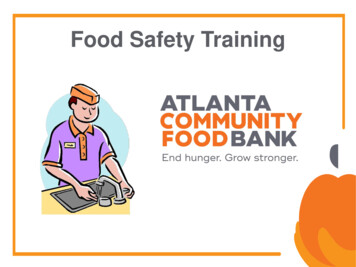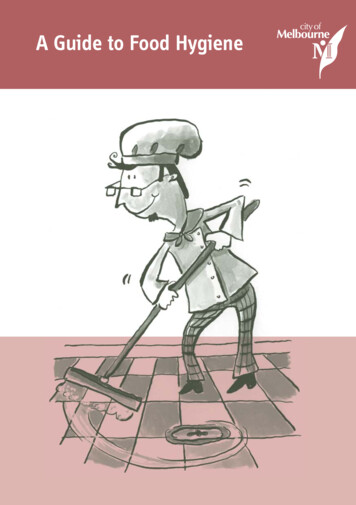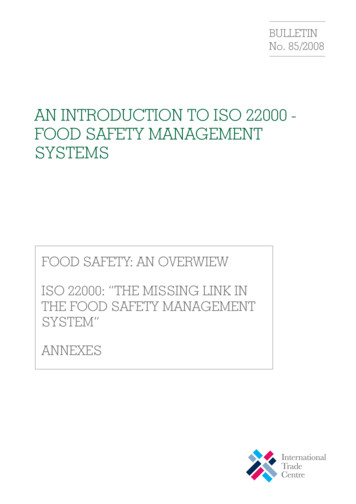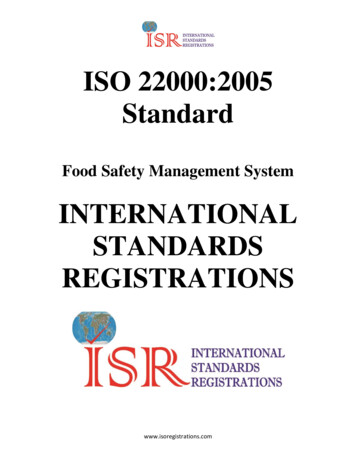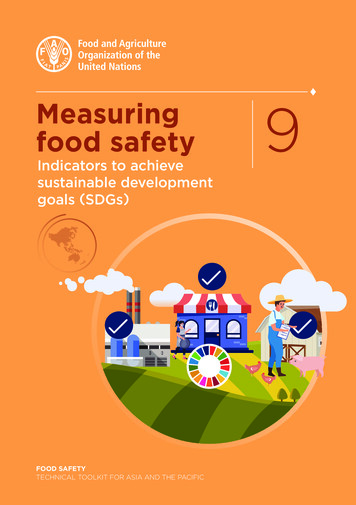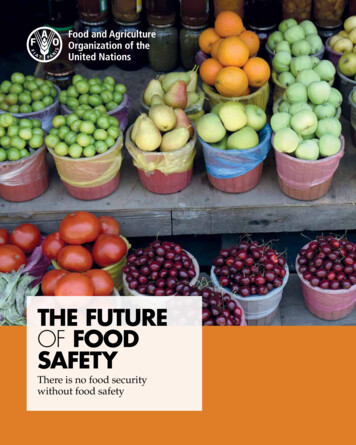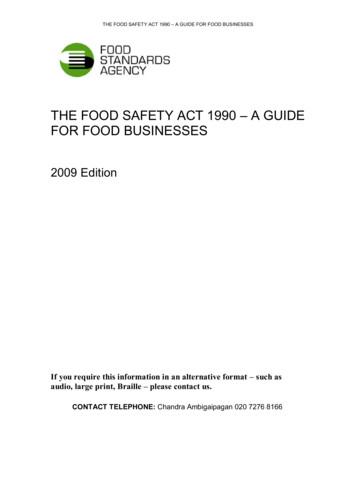
Transcription
THE FOOD SAFETY ACT 1990 – A GUIDE FOR FOOD BUSINESSESTHE FOOD SAFETY ACT 1990 – A GUIDEFOR FOOD BUSINESSES2009 EditionIf you require this information in an alternative format – such asaudio, large print, Braille – please contact us.CONTACT TELEPHONE: Chandra Ambigaipagan 020 7276 8166
T HE FOO D S AF ET Y A CT 1990 – A GU IDE FOR FO OD BUSI NES SE SSummaryIntended audience:The Guidance Notes are intended forRegional coverage:The Guidance Notes are applicable toLegal status:The Guidance Notes are intended tofood businesses.England, Scotland and Wales.provide regulatory guidance on theFood Safety Act 1990.Purpose:The Guidance Notes provide guidanceon the requirements of the FoodSafety Act 1990 in the light ofamendments to the Act and otherrelevant legislation.REVISION HISTORYRevisionRevision datePurpose of revisionRevised byNo.2114 April 2008Draft for consultationBill Drennan223 April 2009Final versionBill Drennan
T HE FOO D S AF ET Y A CT 1990 – A GU IDE FOR FO OD BUSI NES SE SCONTENTSINTRODUCTION . 5Intended Audience . 5Purpose and Legal Status of Guidance Notes . 5Foreword . 5Summary of Responsibilities . 7THE FOOD SAFETY ACT 1990 . 8MAIN AIMS, SCOPE AND DUTIES . 8What is the Food Safety Act 1990? . 8What does the Act aim to achieve? . 8What is the scope of the Act? . 8Does the Food Safety Act stand alone? . 8What does the Act mean by ‘food’? . 9What activities are covered by the Act? . 9Does the Act affect farmers and growers? . 10What does the Act mean for food importers? . 10What does the Act require food businesses to do? . 10THE MAIN OFFENCES. 11What are the main offences under the Food Safety Act? . 11What is meant by ‘rendering food injurious to health’? (section 7) . 11When is food ‘not of the nature or substance or quality demanded’?(section 14) . 12How can food be ‘falsely or misleadingly described or presented’?(section 15) . 12What penalties can be imposed under the Act? . 13DEFENCES TO THE OFFENCES UNDER THE FOOD SAFETY ACT 1990 . 14What is the legal defence of ‘due diligence’? . 14Can retailers of ‘own label’ products offer the defence of ‘duediligence’?. 14Can retailers of ‘branded’ goods offer the defence of ‘due diligence’? . 15What other defences are there? . 153
T HE FOO D S AF ET Y A CT 1990 – A GU IDE FOR FO OD BUSI NES SE SENFORCING THE ACT . 15Who enforces the Act? . 15What is the role of the Food Standards Agency (FSA)? . 16What is the role of Local Government? . 16What are the roles of public analysts and food examiners? . 17How is the Act enforced? . 17What powers of entry do authorised officers have? . 17What is meant by ‘premises'? . 17What are the limits to the authorised officers’ powers of entry? . 18Can officers disclose all the information they find during a visit? . 18Can authorised officers take samples of food? . 18What happens if authorised officers find suspect food? . 18What happens if food is seized but then not condemned? . 19What other powers may be used under the Act by authorised officers wheninspecting food premises? . 19What are emergency control orders? . 20What are Food Alerts? . 20Is there an appeals procedure against actions under the Food SafetyAct? . 21APPENDIX 1 - SOME USEFUL ADDRESSES . 22CENTRAL GOVERNMENT . 22CO-ORDINATING BODIES . 23PROFESSIONAL BODIES . 23INDUSTRY BODIES . 24APPENDIX 2 - KEY PROVISIONS OF THE FOOD SAFETY ACT 1990. 26PART I: PRELIMINARY . 26PART II: MAIN PROVISIONS . 26PART III: ADMINISTRATION AND ENFORCEMENT . 27PART IV: MISCELLANEOUS AND SUPPLEMENTAL . 284
T HE F O O D S A F E T Y AC T 1 9 9 0 – A G U I D E F OR F O O D B US I NE S S E SINTRODUCTIONIntended Audience1.These Guidance Notes are aimed at food businesses.Purpose and Legal Status of Guidance Notes2.The Guidance Notes have been produced to provide informal, non-bindingadvice on the legal requirements of the Food Safety Act 1990 and should beread in conjunction with the legislation itself. The text should not be taken asan authoritative statement or interpretation of the law, as only the courts havethis power. Every effort has been made to ensure that these Guidance Notesare as helpful as possible. However, it is ultimately the responsibility ofindividual businesses to ensure their compliance with the law. Businesseswith specific queries may wish to seek the advice of their local enforcementagency, which will usually be the trading standards/environmental healthdepartment of the local authority. There is further relevant information on theFood Standards Agency website www.food.gov.uk .Foreword3.The safety of food is vital to all consumers and food businesses. Consumersmust have confidence that the food they buy and eat will be what they expect,will do them no harm and that they are protected from fraud. The importanceof this confidence cannot be underestimated for businesses.4.Although food safety legislation affects everyone in the country, it isparticularly relevant to anyone working in the production, processing, storage,distribution and sale of food, no matter how large or small the business. Thisincludes non-profit making organisations.5.As a food business, you should familiarise yourself with the Food Safety Act1990 http://www.opsi.gov.uk/acts/acts1990/ukpga 19900016 en 1.htmwhich, although it has been changed substantially following the introduction ofEuropean food safety legislation, remains very important primary food safetylegislation. It has provided the basis and a flexible framework for muchdomestic food law and applies to the whole of Great Britain1. It concentrateson fundamental issues and leaves the detail to secondary legislation (which isnot specifically covered in this guide).6.This guide updates the previous guide “The Food Safety Act 1990 and You”,issued in 1996 and reprinted in 1997 and 1999. It focuses on the aspects ofthe Act which are of most significance to food businesses, i.e.what the Act requires;1Similar legislation exists in Northern Ireland, the Food Safety (Northern Ireland) Order 1991. FSANorthern Ireland is producing a separate guide to this order.5
T HE F O O D S A F E T Y AC T 1 9 9 0 – A G U I D E F OR F O O D B US I NE S S E Sthe offences under the legislation and possible defences;other actions which can be taken by food authorities;possible defences to these actions.7.We advise managers of medium-sized and larger food businesses to readthe guide in detail and to make the information about the main offences knownto all relevant staff. Small businesses should all note their responsibilitieslisted at the end of this introduction and use the rest of the guide to help thembetter understand these, and for reference about the defences to any legalaction and the powers available to enforcement officers.8.Since 1999 there have been significant changes in food safety law in theUnited Kingdom. In particular, the European Union (EU) adopted the GeneralFood Law Regulation (Regulation (EC) 178/2002), which came fully into effectin 2005. This Regulation created new laws on food safety, traceability,withdrawal and recall of products. Offences for breaches of these laws havebeen put into effect in Great Britain by the General Food Regulations 2004,which has also made changes to the Food Safety Act 1990 itself. In addition,the Food Safety Act 1990 (Amendment) Regulations 2004 changed thedefinition of “food” in the Food Safety Act to bring it in line with Regulation(EC) 178/2002. Guidance Notes on the General Food Law Regulation (EC)178/2002 were published in 2007. These are available s/foodguid/generalfoodlaw .(small businesses may wish to refer in particular to the summary at paragraph8 of those Guidance Notes).9.Food hygiene requirements for businesses are made under powers given bythe Food Safety Act 1990 and the European Communities Act 1972 ratherthan in the Act itself. These are dealt with separately under food law and arecovered by the Food Hygiene Regulations 2006 2 (as amended). There isdetailed guidance on food hygiene legislation oodlaw. Most hygieneenforcement provisions are now made under this legislation rather than theAct. Other legislation made under the Act is not covered in this guide.10. This guidance concentrates on what the main provisions of the Act meanrather than what has to be done to set up a safe food system. It does notprovide information on the requirement3 to operate a food safety managementsystem based on HACCP (Hazard Analysis Critical Control Point) principles.Information on this and the Agency‟s guidance to help small businessescomply with the requirement can be found ygleg/hyglegresources .2There are separate versions of the Food Hygiene Regulations 2006 in England (No.14), Scotland(No.3) and Wales (Welsh S.I. No.31 (W.5))3Article 5(1) of Regulation (EC) 852/20046
T HE F O O D S A F E T Y AC T 1 9 9 0 – A G U I D E F OR F O O D B US I NE S S E SSummary of Responsibilities11. The Act applies to all types of food businesses.12. Your main responsibilities under the Act are:to ensure you do not include anything in food, remove anything from food ortreat food in any way which means it would be damaging to the health ofpeople eating it;to ensure that the food you serve or sell is of the nature, substance or qualitywhich consumers would expect;to ensure that the food is labelled, advertised and presented in a way that isnot false or misleading.7
T HE F O O D S A F E T Y AC T 1 9 9 0 – A G U I D E F OR F O O D B US I NE S S E STHE FOOD SAFETY ACT 1990MAIN AIMS, SCOPE AND DUTIESWhat is the Food Safety Act 1990?13. The Food Safety Act 1990 is wide-ranging legislation on food safety andconsumer protection in relation to food throughout Great Britain.What does the Act aim to achieve?14. The main aims of the Act are:to ensure that all food meets consumers‟ expectations in terms of nature,substance and quality and is not misleadingly presented;to provide legal powers and specify offences in relation to public healthand consumers‟ interest; andto enable Great Britain to fulfil its part of the United Kingdom‟sresponsibilities in the European Union.What is the scope of the Act?15. The Act covers activities throughout the food distribution chain, from primaryproduction through distribution to retail and catering.16. The Act gives the Government powers to make regulations on matters ofdetail. The Food Standards Agency is the principal Government Departmentresponsible for preparing specific regulations under the Act.Does the Food Safety Act stand alone?17. No. Regulation (EC) 178/2002 (the General Food Law Regulation), whichnow provides the basic framework for food law in the EU and UK, is alsoimportant food safety legislation and contains key provisions on food safety(Article 14), presentation (Article 16), traceability (Article 18) and withdrawal,recall and notification of unsafe food (Article 19). Details of where to findGuidance Notes for this Regulation, which should also be read, are atparagraph 8. There is a summary of all the general food law requirements oodlaw.18. The General Food Regulations 2004 and the Food Safety Act 1990(Amendment) Regulations 2004 make substantial amendments to the FoodSafety Act 1990:to implement the requirements of Regulation (EC) 178/2002 andprovide penalties for breaches of these requirements.8
T HE F O O D S A F E T Y AC T 1 9 9 0 – A G U I D E F OR F O O D B US I NE S S E S19. Many of the key provisions in food law are contained in regulations on morespecific areas, which may be made under the powers given in the Food Safety1990 or other legislation such as the European Communities Act 1972. Foodbusinesses also have responsibilities under these regulations. Particularlyimportant are Regulations dealing with:food labelling (e.g. the Food Labelling Regulations 1996);food hygiene (e.g. the Food Hygiene Regulations 2006)4;meat and meat products (such as those concerned with the examinationfor residues and maximum residue limits);food composition;novel foods;food additives; andpackaging materials.What does the Act mean by ‘food’?20. Food” (or “foodstuff”) means5:“any substance or product, whether processed, partially processed orunprocessed, intended to be, or reasonably expected to be ingested byhumans.” „Food‟ includes drink, chewing gum and any substance, includingwater, intentionally incorporated into the food during its manufacture,preparation or treatment. It includes drinking water after the point ofcompliance (which is generally when it comes out of the tap).21. „Food‟ does not include:animal feed;live animals unless they are prepared for placing on the market forhuman consumption (e.g. oysters);plants prior to harvesting;medicinal products;cosmetics;tobacco and tobacco products;narcotic or psychotropic substances;residues and contaminants.What activities are covered by the Act?22. The Act covers operations involved inselling and possessing with a view to sale;free supply in the course of a business6;consigning and delivering;4See footnote 2.The full text, which refers to specific legislation, is in Article 2 of Regulation (EC) 178/2002.6Under section 2(1)(a) of the Act, the supply of the food, otherwise than on sale, in the course of abusiness, shall be deemed to be a sale of the food.59
T HE F O O D S A F E T Y AC T 1 9 9 0 – A G U I D E F OR F O O D B US I NE S S E Spreparing;presentation and labelling;storing;transporting andimporting and exporting food.23. The Act does not in itself cover hygiene, on which there is separate legislationmade using the powers given under the Act, or food prepared in the home fordomestic purposes. It does cover food prepared by childminders in theirhomes for other people‟s children and extends to activities such aspreparation of food in canteens, clubs, schools, hospitals, institutions andpublic and local authorities.Does the Act affect farmers and growers?24. Most farmers are considered to be running food businesses, which the Actdescribes as “any business in the course of which commercial operations withrespect to food or food sources are carried out”. As food businesses, farmsare subject to the improvement and closure procedures outlined at paragraphs79-82, and if farmers sell food directly to the consumer, they will be subject tothe provisions relating to the sale of food.What does the Act mean for food importers?25. The European Union is a single market and therefore there are no importcontrols at borders on food being brought in from other Member States.However, importers of food from countries outside the EU have to comply withthe requirements of EU food law or equivalent conditions.7 Imported food hasto meet food safety and food hygiene requirements equivalent to those for UKproduced food and can be subject to checks by enforcement authorities at UKpoints of import and inland.26. All imported food remains covered by all the main offences outlined inparagraph 27. Enforcement authorities, which in this case include port healthauthorities, have a range of powers to deal with suspect imported food.Therefore, like other UK food businesses, importers have to take allreasonable precautions and exercise due diligence to avoid committing anoffence. They cannot rely solely on warranties provided by someone beyondthe jurisdiction of the courts of Great Britain.What does the Act require food businesses to do?27. In summary, food businesses must ensure that they comply with the Act bynot:rendering food injurious to health (see paragraphs 30-33);selling food which is not of the nature or substance or quality demanded tothe purchaser‟s prejudice (see paragraphs 34-35);7Article 11 of Regulation (EC) 178/200210
T HE F O O D S A F E T Y AC T 1 9 9 0 – A G U I D E F OR F O O D B US I NE S S E Sfalsely describing or presenting food (see paragraphs 36-38).THE MAIN OFFENCESWhat are the main offences under the Food Safety Act?28. The main offences are:rendering food injurious to health (section 7 of the Act);selling, to the purchaser's prejudice, food which is not of the nature orsubstance or quality demanded (section 14); andfalsely or misleadingly describing or presenting food (section 15).29. The previous offence in section 8 of this Act of selling or supplying food notcomplying with food safety requirements no longer exists, owing toamendments in the General Food Regulations 2004 (as amended) as a resultof Regulation (EC) 178/2002. Please see the FSA Guidance Notes onRegulation (EC) 178/2002 referred to in paragraph 8 of this guide for theoffence created under the General Food Regulations 2004 of failing tocomply with Article 14(1) of Regulation (EC) 178/2002, i.e. placing unsafefood on the market.What is meant by ‘rendering food injurious to health’? (section 7)30. If a person renders (which means “makes”) a food injurious to health:by adding an article or substance to it;using an article or substance as an ingredient in its preparation;abstracting (which means “taking away”) any constituent from it; orsubjecting it to any other process or treatmentthen they are guilty of an offence.An example of where a food would be rendered injurious to health by someoneworking in a food business adding an article or substance to it or using it as aningredient in its preparation might be an additive, which had not been approvedand which damaged the consumer‟s health. Removing (abstracting) a necessarypreservative could make a food injurious to health.In considering whether any food is injurious to health, you should look at:the probable immediate or short/ long-term effects of the food on theconsumer;probable toxic effects including those where these result from acombination of substances in the food or the particular health sensitivitiesof a specific category of consumers where the food is intended for thatcategory, for example when it contains an allergen.31. So, adding excessive amounts of sugar to a product aimed at diabetics could11
T HE F O O D S A F E T Y AC T 1 9 9 0 – A G U I D E F OR F O O D B US I NE S S E Srender the food injurious to health. The offence applies whether the act isdeliberate or not (subject to the due diligence test described in paragraphs 4550)32. There is an overlap between this provision and the offence in the GeneralFood Regulations 2004 (as amended)8 of marketing unsafe food. The offencein the Food Safety Act is only relevant, however, when the specific actionsmentioned are applied to the food.When is food ‘not of the nature or substance or quality demanded’? (section14)33. Any person who sells to the purchaser‟s prejudice any food which is not of thenature, or substance, or quality demanded by the purchaser is guilty of anoffence. The „purchaser‟ of food can range from a customer at a shop, to onecompany buying from another. A person may be considered to be a„purchaser‟ even if no money actually changes hands directly, e.g. winningIn practice:“nature” covers a product sold as one thing, but which is in fact another,e.g. haddock sold as cod;“substance” covers situations where the food contains foreign bodies (e.g.an insect) or damaging residues or where there is a statutory or otherstandard for a food and the substance falls below it, for example milkpowder with below the minimum milk protein level. The necessarysubstance for particular products is set through compositional standards incommodity regulations for which separate guidance exists;“quality” covers commercial quality, having regard to any statutorystandards of composition in the food, so an example of food which wouldnot be of the quality demanded would be a stale cake.prizes in a raffle.34. There are often overlaps between these three phrases and with the provisionon unfit food in Article 14 of Regulation (EC) 178/2002. The offence onlyapplies when the purchaser is “prejudiced”, which is when the food being notof the nature or substance or quality demanded is detrimental to them.How can food be ‘falsely or misleadingly described or presented’? (section15)35. This section says that any person who labels or advertises food in a way thatfalsely describes it, or labels, advertises or presents food in a way whichmisleads as to its nature, substance or quality, is guilty of an offence. Theoffence can occur when statements are untrue or pictures of food arepresented in a misleading way. The offence also covers material that is8Regulation 4(b)12
T HE F O O D S A F E T Y AC T 1 9 9 0 – A G U I D E F OR F O O D B US I NE S S E Scorrect but given such emphasis that the purchaser is led to the wrongAn example of where food might be misleadingly presented would be productswhich are not cream but which are presented in traditional cream cartons anddisplayed amongst them.conclusion.36. There is a further offence of misleading presentation in the General FoodRegulations 2004, resulting from Regulation (EC) 178/2002. However, thatoffence only applies when the consumer is misled; the Food Safety Actoffence would also apply both to where consumers and other businesses aremisled. The Consumer Protection from Unfair Trading Regulations 2008 alsocreates offences for misleading actions or omissions and other unfair oraggressive commercial practices. Guidance on these Regulations is availableat http://www.oft.gov.uk/shared oft/business leaflets/cpregs/oft1008.pdf37. Besides the general offence of falsely or misleadingly describing or presentingfood, there are also detailed regulations about the labelling of food. These arethe Food Labelling Regulations 1996, as amended, and guidance on these tes/labelregsguidance/foodlabelregsguid .What penalties can be imposed under the Act?38. The courts decide the level of penalties depending on the circumstances ofeach case, but the Act sets the maximum penalties available to the courts.39. For offences in England and Wales (other than obstruction and relatedoffences), Crown courts may send offenders to prison for up to two yearsand/or impose unlimited fines.40. Magistrates' courts may impose a fine of up to 5,000 per offence and/or aprison sentence of up to six months.41. For offences under sections 7 and 14 of the Act, the maximum fine amagistrates' court may set for each offence is 20,000. There are alsopenalties for obstructing an authorised officer.42. In Scotland, the Sheriff court has a maximum sentence of 12 months andthere is a statutory maximum fine of 10,000.43. Regulations made under the Act may set their own level of penalties which willnot exceed those listed above.13
T HE F O O D S A F E T Y AC T 1 9 9 0 – A G U I D E F OR F O O D B US I NE S S E SDEFENCES TO THE OFFENCES UNDER THE FOODSAFETY ACT 1990What is the legal defence of ‘due diligence’?44. There are two defences under the Food Safety Act which apply to the mainoffences described so far in this guide, and the principal one is the defence of„due diligence‟.45. „Due diligence' is a defence which is designed to balance the protection of theconsumer against defective food with the right of traders not to be convicted ofan offence they have taken all reasonable care to avoid committing. Theresult should be to encourage all concerned to take proper responsibility fortheir products.46. This defence is available where the person charged proves that they „took allreasonable precautions and exercised all due diligence to avoid thecommission of the offence by himself or by a person under his control‟9.Although the burden of proof lies with the person or company accused, theyneed not establish their case beyond all reasonable doubt. They need onlypersuade the court that they exercised due diligence on the balance ofprobabilities.47. The courts will decide what „reasonable care‟ in each case is and will takeaccount of all the facts in that case. For example, a small business might notbe required to undertake the same precautions which would be expected ofone of the major retailers.48. Part of the „due diligence‟ defence may be to show that someone else was atfault. If this is claimed, the food business must give the prosecutioninformation that will enable them to identify who was responsible for theoffence. This must be done seven days before the hearing or, if the defendanthas already appeared before the court, within one month of that appearance.49. The defence of due diligence also applies to offences under the GeneralFood Regulations 2004 and the Food Hygiene Regulations 2006.10Can retailers of ‘own label’ products offer the defence of ‘due diligence’?50. Yes. Retailers of „own label‟ products can be deemed to satisfy the „duediligence‟ defence if they can prove that:the offence was someone else‟s fault (so long as that person was notunder the defendant's control as an employee normally would be) orresulted from their relying on information supplied by that person;9section 21(1) of the Act.There are separate versions of the Food Hygiene Regulations 2006 for the different UKadministrations, see footnote 2.1014
T HE F O O D S A F E T Y AC T 1 9 9 0 – A G U I D E F OR F O O D B US I NE S S E Sthey made reasonable checks on the food or reasonably relied on checksmade by the supplier; andthey had no reason to suspect that they were committing an offence.Can retailers of ‘branded’ goods offer the defence of ‘due diligence’?51. Yes. Retailers of „branded‟ goods can be deemed to satisfy the „due diligence‟defence if they can prove that:the offence was someone else‟s fault (so long as that person was notunder the defendant's control as an employee normally would be) orresulted from their relying on information supplied by another person;andthey could not reasonably have been expected to know that they werecommitting an offence.In this instance the retailer is not required to have carried out reasonablechecks of the food supplied to him.What other defences are there?52. Besides „due diligence‟, the other defences specified by the Act are:i.where the commission of an offence was due to the act or default ofanother person; andii.a defence for those charged with an offence related to the advertisementsfor sale of food, whose business it is to publish or arrange for thepublication of such advertisements and who had no reason to suspectthat publishing or arranging to publish an advertisement in the course oftheir business would amount to an offence. However, regulations madeunder the Act can set their own defences.ENFORCING THE ACTWho enforces the Act?53. The day-to-day work of enforcement is, in the main, the responsibility ofenvironmental health practitioners and trading standards officers from local(food) authorities. The Food Standards Agency enforces some regulationsmade under the Act (for example, licen
to ensure you do not include anything in food, remove anything from food or treat food in any way which means it would be damaging to the health of people eating it; to ensure that the food you serve or sell is of the nature, substance or quality which consumers would expect;



